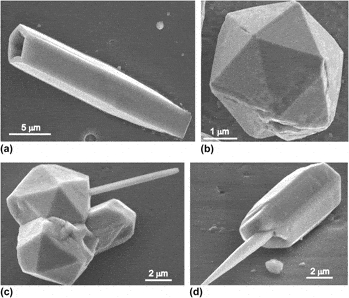Crossref Citations
This article has been cited by the following publications. This list is generated based on data provided by
Crossref.
Shodja, Hossein M.
Rezazadeh-Kalehbasti, Shaghayegh
and
Gutkin, Mikhail Yu
2013.
Wedge disclination dipole in an embedded nanowire within the surface/interface elasticity.
Journal of the Mechanical Behavior of Materials,
Vol. 22,
Issue. 5-6,
p.
161.
Vikarchuk, A. A.
and
Dorogov, M. V.
2013.
Features of the evolution of the structure and morphology of the surface of icosahedral copper particles in the annealing process.
JETP Letters,
Vol. 97,
Issue. 10,
p.
594.
Luo, Jun
Li, Zhenhuan
and
Xiao, Zhongmin
2014.
On the stress field and crack nucleation behavior of a disclinated nanowire with surface stress effects.
Acta Mechanica,
Vol. 225,
Issue. 11,
p.
3187.
Romanov, A. E.
Dorogin, L. M.
Kolesnikova, A. L.
Kink, I.
Yasnikov, I. S.
and
Vikarchuk, A. A.
2014.
A model of whisker crystal growth from a pentagonal small particle.
Technical Physics Letters,
Vol. 40,
Issue. 2,
p.
174.
Gutkin, M. Yu.
and
Panpurin, S. N.
2014.
Equilibrium ensembles of quantum dots in atomically inhomogeneous pentagonal nanowires.
Physics of the Solid State,
Vol. 56,
Issue. 6,
p.
1187.
Yasnikov, I.S.
Kolesnikova, A.L.
and
Romanov, A.E.
2015.
Multi-disclinational description of pentagonal particles with subsurface layer free of twin boundaries.
Philosophical Magazine Letters,
Vol. 95,
Issue. 9,
p.
450.
Gutkin, M.Yu.
Kolesnikova, A.L.
Krasnitckii, S.A.
Dorogin, L.M.
Serebryakova, V.S.
Vikarchuk, A.A.
and
Romanov, A.E.
2015.
Stress relaxation in icosahedral small particles via generation of circular prismatic dislocation loops.
Scripta Materialia,
Vol. 105,
Issue. ,
p.
10.
Marks, L D
and
Peng, L
2016.
Nanoparticle shape, thermodynamics and kinetics.
Journal of Physics: Condensed Matter,
Vol. 28,
Issue. 5,
p.
053001.
Gutkin, Mikhail Yu.
Kolesnikova, Anna L.
Yasnikov, Igor S.
Vikarchuk, Anatoly A.
Aifantis, Elias C.
and
Romanov, Alexey E.
2018.
Fracture of hollow multiply-twinned particles under chemical etching.
European Journal of Mechanics - A/Solids,
Vol. 68,
Issue. ,
p.
133.
Dorogin, Leonid M.
Dorogov, Maksim V.
Vlassov, Sergei
Vikarchuk, Anatoly A.
and
Romanov, Alexey E.
2020.
Whisker Growth and Cavity Formation at the Microscale.
Reviews on advanced materials and technologies,
Vol. 2,
Issue. 1,
p.
1.
Romanov, A.E.
and
Kolesnikova, A.L.
2021.
Elasticity Boundary-Value Problems for Straight Wedge Disclinations. A Review on Methods and Results.
Reviews on advanced materials and technologies,
Vol. 3,
Issue. 1,
p.
55.
Lu, Juanjuan
Zhang, Di
Paldi, Robynne L.
He, Zihao
Lu, Ping
Deitz, Julia
Ahmad, Ahmad
Dou, Hongyi
Wang, Xuejing
Liu, Juncheng
Hu, Zedong
Yang, Bo
Zhang, Xinghang
El-Azab, Anter A
and
Wang, Haiyan
2023.
Abnormal in-plane epitaxy and formation mechanism of vertically aligned Au nanopillars in self-assembled CeO2–Au metamaterial systems.
Materials Horizons,
Vol. 10,
Issue. 8,
p.
3101.
Marks, Laurence. D.
2023.
Encyclopedia of Nanomaterials.
p.
383.
Krasnitckii, S. A.
Shevchuk, R. E.
Naumov, D. K.
Kolesnikova, A. L.
Gutkin, M. Yu.
Romanov, A. E.
and
Smirnov, A. M.
2025.
Strain energy in multi-twinned icosahedral particles: analytical and finite element analysis.
Journal of Materials Science,
Vol. 60,
Issue. 11,
p.
5137.


